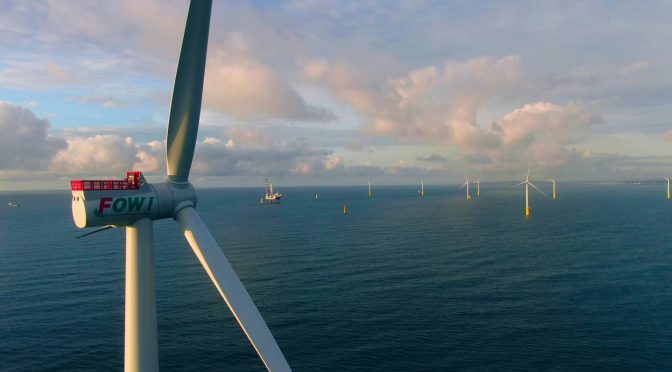Japan’s leading power provider took its first major step in developing Asia’s promising wind energy market with the completion of Taiwan’s first commercial offshore wind farm.
JERA, a joint venture between utilities Tokyo Electric Power Co. Holdings and Chubu Electric Power, owns 32.5% of the Formosa 1 wind farm off northwestern Taiwan, slated to begin operation by the end of 2019. Denmark’s Orsted, the global offshore wind power leader, invested 35% in the project, which offers a capacity of 130 megawatts.
“We expect to learn extensively and grow in this leading place for offshore wind energy, then expand to Japan and the rest of the world,” JERA President Satoshi Onoda said at Tuesday’s completion ceremony.
JERA also holds a 49% stake in Formosa 2, due to generate 376 MW once it starts commercial operation in 2021.
The Japanese power provider is negotiating for a roughly 40% stake in the operator of Formosa 3 as well, looking to finalize a deal as soon as year-end. With a capacity of 2 gigawatts, the project is designed to be one of the biggest offshore wind farms on the planet.
Formosa 3, projected to begin operation between 2026 and 2030, is anticipated to cost the equivalent of 1 trillion yen ($9.17 billion).
Total costs for Formosa 1 are estimated at 100 billion yen, with the figure rising to a few hundred billion yen for the second project.
Project financing is being considered for Formosa 3, with JERA expected to invest about 100 billion yen. The Japanese company’s share of total wind power output in Taiwan would equate to about 1 GW, on par with one nuclear reactor.
The International Renewable Energy Agency estimates that 228 GW worth of offshore wind generators will be installed by 2030 — almost 10 times the current level.
Asia is expected to replace pioneering European countries as the driver of demand. While Asian countries seek substitutes for coal-fired electricity, the region also needs new sources of power to support economic growth.
Taiwanese President Tsai Ing-wen looks to reduce the island’s dependence on nuclear energy by shifting to wind power. Her administration aims to have offshore wind farms generate about 5.7 GW by 2025, accounting for 7% of Taiwan’s energy mix.
“Taiwan has taken in technology and funding from abroad, and we have become the trailblazer for offshore wind power generation in Asia,” Tsai said at Tuesday’s ceremony.
JERA was formed in 2015 as an importer of liquefied natural gas. The venture took over the domestic thermal power business at both Japanese utilities this April.
The 68.5 GW of generating power now housed at JERA corresponds to half of Japan’s thermal power capacity. But the global push to cut carbon emissions, along with a shrinking electricity market at home, drove the company to develop the renewable energy business overseas.
Overseas power generation produces about 20% of JERA’s net profit, and the company intends to raise the share to 30% by fiscal 2025. This goal depends on expanding the global renewable energy business to 5 GW from 1.1 GW today.
To achieve those targets, “Taiwan is crucial,” a source close to JERA said.
The company faces an increasingly crowded market. Japan’s JXTG Nippon Oil & Energy, Sojitz and Chugoku Electric Power are forming a consortium with other businesses to develop a wind farm off the western coast of Taiwan.
Japanese trading house Marubeni created a joint venture with Taiwanese companies that manufacture wind turbines. They plan to build their own wind farm off western Taiwan as well.
Orsted looks to develop a separate 900 MW offshore wind project.
“Taiwan will become the opening phase of a battle to capture market share in Asian offshore wind power,” a Japanese electricity industry insider said.
SUGURU KURIMOTO, Nikkei staff writer


